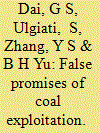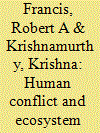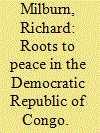|
|
|
Sort Order |
|
|
|
Items / Page
|
|
|
|
|
|
|
| Srl | Item |
| 1 |
ID:
150895


|
|
|
|
|
| Summary/Abstract |
Fossil fuels face resource depletion, supply security, and climate change problems; renewable energy (RE) may offer the best prospects for their long-term replacement. However, RE sources differ in many important ways from fossil fuels, particularly in that they are energy flows rather than stocks. The most important RE sources, wind and solar energy, are also intermittent, necessitating major energy storage as these sources increase their share of total energy supply. We show that estimates for the technical potential of RE vary by two orders of magnitude, and argue that values at the lower end of the range must be seriously considered, both because their energy return on energy invested falls, and environmental costs rise, with cumulative output. Finally, most future RE output will be electric, necessitating radical reconfiguration of existing grids to function with intermittent RE.
|
|
|
|
|
|
|
|
|
|
|
|
|
|
|
|
| 2 |
ID:
137668


|
|
|
|
|
| Summary/Abstract |
The belief that small hydropower (SHP) systems are sources of clean energy with few or no ecological problems has been driving the rapid expansion of SHP plants in China and elsewhere. This paper presents an evaluation of the ecological impacts of SHP based on an emergy analysis of a plant located in Guizhou Province in southwest China. The results suggest that periodic downstream drying-up of the river is the largest contributor to the induced ecological impacts in terms of emergy cost. In 2010, the ecosystem service losses caused by downstream ecosystem degradation totaled 2.35E+18 seJ, which accounts for 38% of the total emergy utilized in the annual operation of this plant. If such losses could be avoided, i.e., if the SHP operated as designed, SHP projects would produce relatively modest impacts on the environment. When the reaches downstream of the SHP plant are not affected, the environmental loading ratio (ELR) is 2.20 and the emergy sustainability index (ESI) is 0.93; however, the ELR increases to 3.82 and ESI decreases to 0.38 when river drying-up occurs. These results indicate that China should rigorously investigate potential ecological problems of SHP development and proceed with caution rather than readily believing unjustified assumptions.
|
|
|
|
|
|
|
|
|
|
|
|
|
|
|
|
| 3 |
ID:
128345


|
|
|
|
|
| Publication |
2014.
|
| Summary/Abstract |
The grasslands of Inner Mongolia are not only the source of the necessary resources for the survival and development of herdsmen, but also represent a significant green ecological barrier in North China. Coal-mining production is important in maintaining GDP growth in Inner Mongolia. However, over-exploitation has created serious problems, such as pollution of the environment and significant decreases in grassland ecosystem services, in addition to impacting the well-being of herdsmen and other humans. Based on questionnaires survey performed among 864 herdsmen addressing the relationship between coal exploitation in grasslands and human well-being in Xilinguole League in Inner Mongolia, we found that (1) coal resource exploitation in these grasslands does not benefit the herdsmen by increasing their income; (2) the rapid development of this resource has not obviously materially improved the life of the herdsmen; and (3) these activities have increased the risks that herdsman will have to endure in the future. Overall, coal resource exploitation in grasslands has more negative than positive effects on the well-being of herdsmen. We propose the conservation of coal resources and improvement of ecological compensation should be carried out without blindly pursuing economic growth, instead of focusing on economic development and structural adjustments.
|
|
|
|
|
|
|
|
|
|
|
|
|
|
|
|
| 4 |
ID:
150465


|
|
|
|
|
| Summary/Abstract |
The evaluation, monitoring and reduction of the heating and cooling consumptions are topics of increasing importance. One promising technology is the geothermal heat pump. Despite its undoubted advantages compared to fossil fuels in terms of RES production, CO2 reduction and primary energy savings, there are still significant barriers for the creation of sustainable local markets. Many regions present similar conditions in terms of climate, geology, hydrogeology, infrastructure and political conditions. Because of the context-driven nature of shallow geothermal systems, similarities should be taken into account and strategies shared across borders to foster the introduction and exploitation of shallow geothermal energy.
|
|
|
|
|
|
|
|
|
|
|
|
|
|
|
|
| 5 |
ID:
133286


|
|
|
|
|
| Publication |
2014.
|
| Summary/Abstract |
Environmental degradation resulting from warfare is a growing concern, particularly with increasing recognition of humanity's dependence on healthy ecosystems. Though environmental legislation does exist that seeks to prevent or mitigate environmental harm before, during and after conflict, it has limited scope and effectiveness. This may be one reason why the environmental laws of war are so rarely applied in attempts to bring parties responsible for environmental harm to justice. Enforcement of such legal instruments also requires appropriate quantification of environmental damage, which is particularly difficult in a warfare context. A focus on the loss of environmental resources, habitats or ecosystems is only part of the story-the real cost of environmental damage is in the loss of ecosystem services that such resources provide, both now and in the future, and which regional and global human societies depend upon. The ecosystem services framework, wherein the costs of damage to ecosystem services are quantified in economic terms, may prove a more effective way of highlighting the environmental damage resulting from warfare. Moreover, quantification along monetary lines is potentially more likely to establish a solid case for justifiable reparations than criteria relating to loss of biodiversity or ecosystem health, which are more difficult for society and governmental agencies to place specific values on. This article discusses the ecosystem services framework in the context of warfare, and highlights both the potential and the challenges that may accompany adoption of such a framework by the international community.
|
|
|
|
|
|
|
|
|
|
|
|
|
|
|
|
| 6 |
ID:
168675


|
|
|
|
|
| Summary/Abstract |
This paper models landscape sustainability in the oil-producing Niger Delta area of Nigeria. Simon decision making cycle (intelligence-design-choice) was used to examine landscape sustainability planning issues. This approach involves three levels of application namely intelligence, design, and choice. Probability topic model was used in R software to identify the key problems in the Niger Delta area as (1) oil spillage impacts on water/land use (landscape capital) and (2) militancy (vandalism) and leadership (planning). These problems significantly, affect the landscape capital in the Niger Delta area. System dynamic simulation was applied to evaluate landscape capital under different scenarios of vandalism and different levels of revenue allocation. The study found that the greatest landscape capital can be achieved in 18.25 years if the revenue allocation to the Niger Delta oil producing states is increased from the current level of 13 percent to 21 percent. These results are consistent with UNEP's report that highlights oil spillages in the Niger Delta area as affecting landscape sustainability in the area.
|
|
|
|
|
|
|
|
|
|
|
|
|
|
|
|
| 7 |
ID:
115151


|
|
|
|
|
| Publication |
2012.
|
| Summary/Abstract |
This study presents a linear profit model with combined economic and environmental factors for a switchgrass-for-biofuels agricultural system in the southeastern U.S. The objectives are to establish conversion-to-switchgrass thresholds for various market prices and identify policy incentives that would ensure economic profit while also maximizing environmental benefits (carbon sequestration, displacement of fossil fuels) and minimizing negative impacts (global warming potential, nitrate loss). Weighting factors are chosen to represent incentives and penalties by assigning value to the impacts. With no other incentives, switchgrass market prices of at least $51 and $58/dton would be needed in order to make a profitable switch from corn/Conservation Reserve Program (CRP) lands and cotton, respectively. At a mid-range offering of $50/dton, feasible carbon credit prices of $3/ $8/ $23 per metric tonne CO2e would incentivize conversion from corn, CRP, or cotton, respectively. Similarly, a water quality penalty of $0.20/ $3/ $2 per kilogram NO3-N leached would incentivize the same conversions with resultant watershed improvement. At a lower price of $30/dton switchgrass, incentives based on valuation of ecosystem services begin to exceed feasible ranges of these valuations.
|
|
|
|
|
|
|
|
|
|
|
|
|
|
|
|
| 8 |
ID:
133287


|
|
|
|
|
| Publication |
2014.
|
| Summary/Abstract |
The Democratic Republic of Congo (DRC) is endowed with an abundance of natural resources, and the presence of high-value resources such as coltan and diamonds is well known. The country is also endowed with a wealth of biodiversity, although the value of this is often overlooked. This article describes the detrimental impact of armed conflict on this biodiversity and the dangers posed by the return of peace, which is likely to result in increased biodiversity exploitation. The resulting loss of key carbon sinks crucial to the global fight against climate change will affect not only the DRC, but also the international community. Biodiversity is therefore identified as a threat to security but also a valuable asset for development, and this article discusses methods to realize the value of biodiversity in the DRC through the benefits of ecosystem services and income generated from monetizing biodiversity. It concludes by arguing that the false dichotomy of conservation and development as separate entities and objectives needs to change so that conservation becomes a central pillar of security and development work in the DRC and other regions of current or recent armed conflict around the world.
|
|
|
|
|
|
|
|
|
|
|
|
|
|
|
|
| 9 |
ID:
107656


|
|
|
|
|
| Publication |
2011.
|
| Summary/Abstract |
This article contributes to our understanding of transboundary environmental management regimes through the application of an analytical framework that facilitates an exploration of the co-existence of conflict and cooperation. Rather than framing conflict and cooperation as mutually exclusive states at opposite ends of a spectrum, we seek to understand the ways in which cooperation can exist at the same time as conflict. We apply this framework to a study of conservation management in a transboundary area at the intersection of the Democratic Republic of Congo, Rwanda and Uganda. We identify two actual and one hypothetical phase of conflict-cooperation relations, in a landscape notorious for some of the worst violence of the last two decades. We map the evolution of phases of transboundary protected area management against the evolving security context, and we find that this approach has greater explanatory power than previous approaches that polarize conflict and cooperation. In particular, it helps us to understand the drivers of environmental cooperation, including the evolving characteristics of that cooperation. This new way of understanding the relationship between environmental management and security also enables us to reconsider the potential for environmental management to be instrumental in working towards interstate security objectives, for example through peace parks. We don't find that the 'low politics' of environmental management should be seen as a predictable and manageable determinant of international relations. But an understanding of the coexistence of conflict and cooperation does also point to a more complex, non-linear relationship between low and high politics.
|
|
|
|
|
|
|
|
|
|
|
|
|
|
|
|
|
|
|
|
|